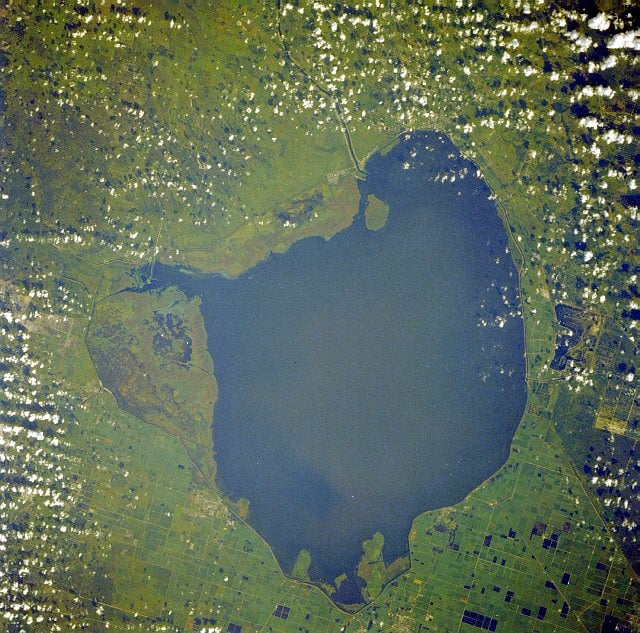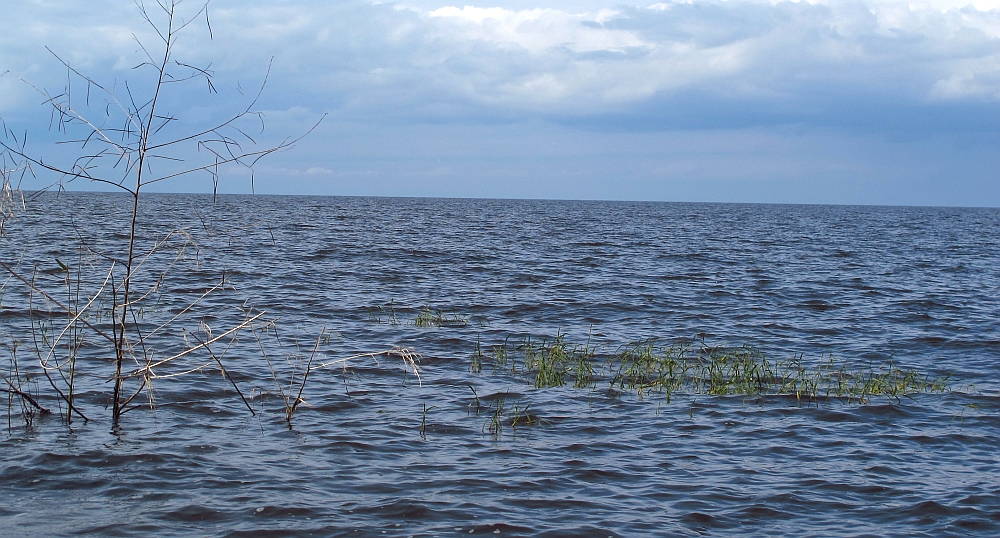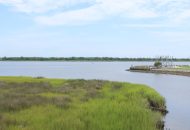Tensions Mount in Florida Over Massive Lake Okeechobee Algae Bloom

PALM BEACH, Fla. – It’s not a good time to be a state or federal official with oversight over South Florida’s long abused plumbing system.
In just the past several days, a coalition of environmental groups has called on Gov. Ron DeSantis to declare a state of emergency to protect coastal streams and lagoons from a looming environmental catastrophe.
And Republican Rep. Brian Mast, whose Florida district encompasses a coastal swath stretching south from Port St. Lucie to Jupiter, has actually threatened to sue the U.S Army Corps of Engineers for “reckless decision-making” if it allows annual “lake releases” to go forward as planned.
The massive problem is Lake Okeechobee, the largest freshwater lake in the state and eighth largest freshwater lake in the entire country.
In early May, the National Oceanic and Atmospheric Administration reported that nearly two-thirds of the lake, an area of about 500-square-miles, was covered with blue-green algae.
If the algae just stayed there, that would be bad enough, but Florida has for decades used the lake as a reservoir to hold rainwater during the dry winter months, and then drains it, to the east and to the west, so that it effectively serves as a huge bowl to capture the stormwater the annual hurricane season brings.
For years, environmentalists and those in the sports fishing and tourism industry have complained loudly that the releases from the lake carry toxins that result in lesioned fish and other environmental damage.
In 2018, an algae bloom about the size of the one currently covering the lake meshed with red tide blooms along the coast, shutting down local beach economies and leaving hundreds if not thousands sick.
Just last week, Gov. DeSantis toured the lake and called on the Army Corps to forgo lake releases to the west, into the Caloosahatchee River system, and east, into the St. Lucie River.
Instead, he said, the Army Corps should develop a plan to send as much water as it can to the south during the state’s dry season.
“There needs to be an emphasis to keep the lake at a more manageable level during the dry season so when we did have the rainy season you would not be needing to hopefully discharge any water,” DeSantis said.
The water level in the massive lake is currently more than 1 foot above the Army Corps regulation schedule for the June 1 start of the hurricane season.
Speaking to reporters in Fort Myers, Fla., DeSantis said, “When you’re releasing massive quantities of water into these estuaries you can have all the water quality components in the world, but just the sheer volume of that is going to create problems.”
He said he previously asked the South Florida Water Management District to release all the water it can to the south, and so far, “they’ve been doing that.”
But the Army Corps, which had been sending more water to the south, announced in December that it did not plan to release water during the dry season.
Instead, it said it will discharge 1,500 cubic feet of water per second west into the Caloosahatchee in a series of pulses, and send about 51% of the water south. So far, the St. Lucie River has been spared any lake releases this year, but that could change as conditions change.
In a letter to the Army Corps’ Lt. Gen. Scott Spellman, Mast said algal blooms on Lake Okeechobee have tested “100 times too toxic for human contact.”
He also challenged Spellman to visit the area and see what is going on first hand.
“If you are going to poison our community yet again you should first look in the eyes of the men, women and children whose lives you are putting at risk with your reckless decision making,” Mast said.
A Little History
Spanish explorers were the first non-indigenous men to see the lake, happening upon it in the 16th Century. By then, the people inhabiting the region had likely been calling it “Mataimi,” or “big water,” for a millennium.
From that time until about the 1960s, attempts to settle around the lake were tried and abandoned. Despite the fertility of the land around its rim, farming on anything but an industrial scale was difficult and unprofitable — and that’s to say nothing of the local fauna, which included once abundant alligators and Florida panthers.

Things changed significantly for the life of the lake in 1926, when a storm called the Great Miami Hurricane passed through the area, killing about 300 people. Two years later, a storm that would come to be known as the Okeechobee Hurricane crossed directly over the lake, killing an estimated 2,500.
In both cases the catastrophe was caused by flooding from a storm surge when strong winds drove water over the modest mud dike that circled the lake at the time.
In response, the Florida legislature created the “Okeechobee Flood Control District,”which was authorized to cooperate with the U.S. Army Corps of Engineers in actions to prevent similar disasters.
Soon, land extending east and west, not to mention south to the Everglades, was crisscrossed with channels and canals. Not all that much later, the U.S. sugar industry would set up operations south of the lake, and as its needs grew, so too did the height of the Lake Okeechobee dike.
What followed was a cycle as predictable as the seasons. When it rained during the summer months, the water would be captured in Lake Okeechobee, with some of it being drawn off by the surrounding agriculture concerns, and some held onto in case a drought took hold before the return of the rainy season.
The bottom line was the lake never got low enough during the dry tourist season to be left alone when the rains returned. Each spring, massive amounts of water, all of it polluted by agricultural and other runoff, would be flushed toward the coasts.
Seen from the air, the result could be astonishing. In the early 2000s, for instance, a pair of newspaper photographers chartered a plane a few days after lake releases had started sending water into the St. Lucie River.
What they captured were photographs of a large brown smudge, swiftly moving eastward and pushing past the Indian River Lagoon before finally punching into the ocean.
With that, the controversy over the management of the water was renewed again. Never completely resolved and never completely out of mind.
“Time and time again, we’re reminded of just how delicate Florida’s ecosystem is, and what is at stake if we don’t preserve it,” Rep. Stephanie Murphy, a Democrat, told The Well News recently. “I’m troubled that algae is again contaminating Lake Okeechobee and could ultimately reach the east and west coasts of the state.
“Congress has already passed two of my measures to fund research and economic impact studies on harmful algae blooms – but more work needs to be done. Florida’s water quality, recreation and tourism, and economy are at stake,” she said.
The first of the two measures Murphy provided $1.75 million to the National Oceanic and Atmospheric Administration to research ways to reduce harmful algae blooms.
The last time a similar study was conducted was in 2006. Murphy’s measure requires the new study to examine the effects of harmful algal blooms on public health, drinking water, commercial fisheries, property values, and recreation and tourism.
The purpose of the study is to increase public awareness about the serious consequences of harmful algal blooms, which will push policymakers at the federal, state and local levels to dedicate more attention and resources to address this problem.

The second measure provided NOAA with $1 million to sponsor a much-needed study on the economic impacts of HABs, both nationally and in hard-hit states like Florida.
The measure was cosponsored by a bipartisan group of Murphy’s colleagues including Democrats Mary Kaptur of Ohio, Darren Soto and Charlie Crist of Florida, and Suzanne Bonamici of Oregon, and Republicans Brian Mast and Bill Posey, of Florida.
“Florida families are at the frontlines of the dangers associated with the rise of harmful algal blooms across our shores,” Murphy said when she introduced the measures. “We need the best available data on the potential health and economic hazards associated with this environmental crisis.
‘These bipartisan measures will move us a step closer towards solutions that will help reverse the way algal blooms are endangering the health of all Floridians and the well-being of local businesses that drive our tourism industry,” she added.
House Passes Legislation to Address Algae Issues
Last week, the fight to address Lake Okeechobee’s ills and protect Florida’s coastal waters and communities was renewed by the House passage of the National Estuaries and Acidification Research Act .
Sponsored by Reps. Mast, Posey and Bonamici, the bill was included in a package of other legislation approved by vote of 350-75. Its aim is to fight the myriad impacts of the lake releases, including coastal acidification, and help restore the critical Florida habitats of St. Lucie Estuary, Caloosahatchee Estuary, Indian River Lagoon and Lake Worth Lagoon.
“On the Treasure Coast and in the Palm Beaches, we’ve seen what happens when estuaries are left to die—businesses are forced to close, animals are killed and people get sick,” Mast said. “That cannot be allowed to happen, so this legislation is critical, and it’ll go a long way toward protecting marine life and promoting healthier communities.”
The NEAR Act directs the National Academies of Science Ocean Study Board to conduct a two-year study examining the science of ocean acidification and its impact on estuaries. The goal of the NEAR Act is to create a better understanding of coastal acidification so government agencies can better manage and mitigate its effects on our nation’s estuaries and other water bodies.
“Estuaries are some of the most diverse ecosystems in the country, and because estuaries are places where freshwater mixes with salt water from the oceans, preserving this delicate balance is necessary but also challenging,” Posey said. “This critical legislation will help protect our estuaries by ensuring that we continue to study and monitor the effects of coastal acidification.”
“By absorbing carbon dioxide and polluted runoff, our estuaries are becoming more acidic,” Bonamici said. “Unfortunately, research has not kept pace with the needs of coastal communities to fully understand the ecological and socioeconomic consequences. This legislation will address the research gap and help preserve our nation’s estuaries.”

























